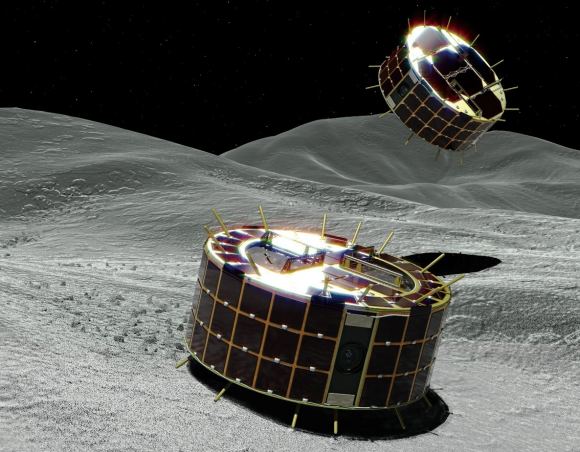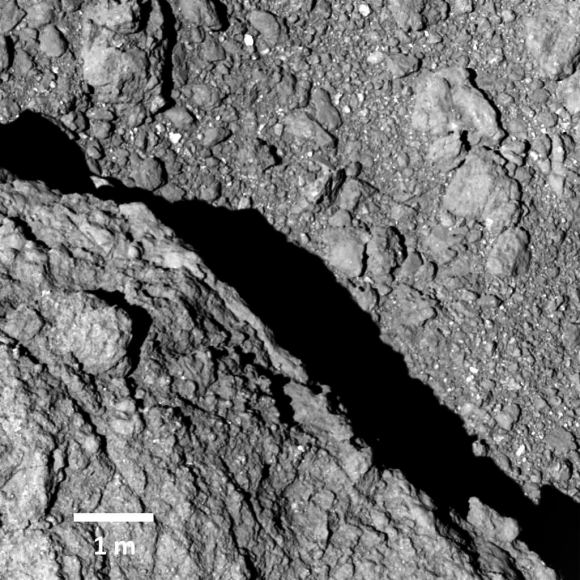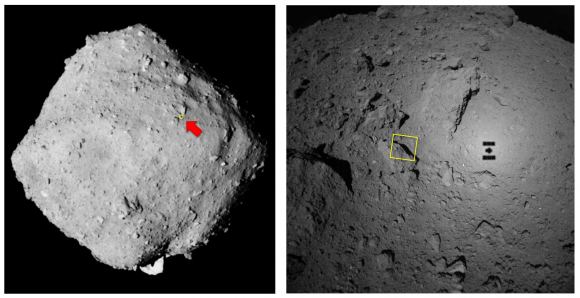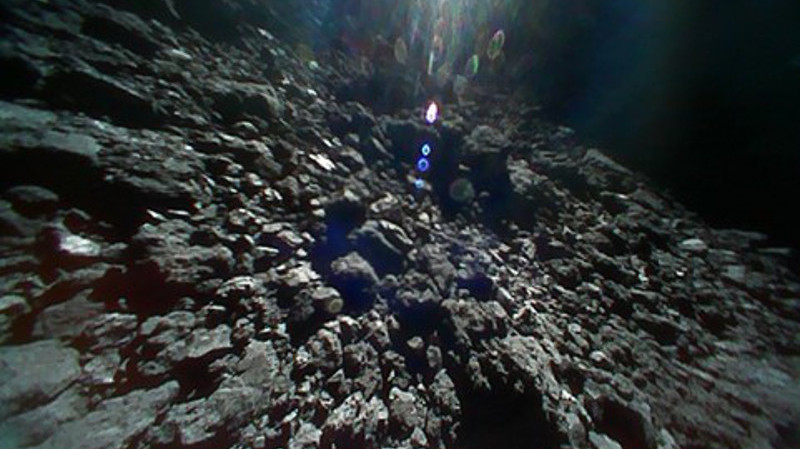In December of 2014, the Japanese Aerospace Exploration Agency (JAXA) launched the Hayabusa2 mission. As the second spacecraft to bear this name, Hayabusa2 was deployed by JAXA to conduct a sample-return mission with an asteroid. By studying samples of the near-Earth asteroid 162173 Ryugu, scientists hope to shed new light on the history of the early Solar System
The spacecraft arrived in orbit around Ryugu in July of 2018, where it will spend a total of a year and a half surveying the asteroid before returning to Earth. On September 23rd, the satellite deployed its onboard MINERVA-II rovers onto the surface of Ryugu. According to the latest updates from JAXA, both rovers are in good condition and have recently sent back photographs and a video of the asteroid’s surface.
The MIcro Nano Experimental Robot Vehicle for Asteroid– II (MINERVA-II) rovers are so-named because they are the second generation of the robotic explorer, the first generation of which (MINERVA) were deployed from the first Hayabusa mission back in 2005. Unfortunately, the rover failed to reach the surface of its intended asteroid (25143 Itokawa), due to an error that occurred during deployment.

And whereas MINERVA was a min-lander, the second generation are true rovers, capable of hopping around the surface to collect information. This is accomplished by the use of a small motor that produces the tiny amount of force needed to propel the rover. This design feature was intentional since wheels and treads would send the probes back into space due to Ryugu’s low-gravity environment.
This time around, both rovers managed to make it to the surface and began sending back images shortly thereafter. The video shown below is especially stunning, and consists of 15 frames that were captured by Rover-1B on September 23rd at about the same time that Rover-1A landed on the surface. As Yuichi Tsuda, the Hayabusa2 Project Project Manager, expressed in a recent JAXA press release:
“I cannot find words to express how happy I am that we were able to realize mobile exploration on the surface of an asteroid. I am proud that Hayabusa2 was able to contribute to the creation of this technology for a new method of space exploration by surface movement on small bodies.”
As you can see, the video shows Ryugu’s rocky, grey and dust-covered surface, with the Sun moving in the background from right to left. This video was quite the achievement, providing a glimpse of what it is like to stand on the surface of an asteroid that is traveling through our Solar System at speeds of up to 33 km/s (20.5 mi/s).\
“I was so moved to see these small rovers successfully explore an asteroid surface because we could not achieve this at the time of Hayabusa, 13 years ago,” said Makoto Yoshikawa, the Hayabusa2 Project Mission Manager. “I was particularly impressed with the images taken from close range on the asteroid surface.”
According to Tetsuo Yoshimitsu, the engineer responsible for the Hayabusa2 Project MINERVA-II1, the initial images were a bit blurry, but effectively demonstrated the abilities of the mission:
“Although I was disappointed with the blurred image that first came from the rover, it was good to be able to capture this shot as it was recorded by the rover as the Hayabusa2 spacecraft is shown. Moreover, with the image taken during the hop on the asteroid surface, I was able to confirm the effectiveness of this movement mechanism on the small celestial body and see the result of many years of research.”

While moving closer to the surface to deploy the MINERVA-II rovers, the Hayabusa2 spacecraft took the highest-resolution image of the asteroid’s surface so far. This image (shown below) was taken with the spacecraft’s Optical Navigation Camera-Telescopic (ONC-T) camera on September 22nd, when the spacecraft was at an altitude of about 64 meters (210 feet) from the surface.
The image showcases the craggy and bumpy nature of Ryugu’s surface even better than those obtained by the rovers. A second set of images (below) shows where this photographed region is in relation to the rest of the asteroid. The image on the right was taken from an altitude of 70 meters (230 feet) from the surface, and the spacecraft’s shadow can be seen nearby.
The image on the left was acquired once the spacecraft had returned to its home position altitude – approximately 20 km (12.4 mi) above the center of the asteroid. These images are also notable for being of a much higher resolution than those that were obtained by the Hayabusa spacecraft of the asteroid Itokawa in 2006.

And as Takashi Kubota, JAXA’s spokesperson for the Hayabusa2 Project (and also responsible for the MINERVA-II1) expressed about the rovers’ successful landing:
“The good news made me so happy. From the surface of Ryugu, MINERVA-II1 sent a radio signal to the Earth via Hayabusa2 S/C. The image taken by MINERVA-II1 during a hop allowed me to relax as a dream of many years came true. I felt awed by what we had achieved in Japan. This is just a real charm of deep space exploration.”
The next step for the Hayabusa2 mission is the deployment of the Mobile Asteroid Surface Scout (MASCOT), a lander that was developed by the German Aerospace Center (DLR) in cooperation with the French space agency (CNES). Once deployed, MASCOT will use a suite of four instruments to study the small-scale structure, distribution and texture of the asteroid’s regolith.
The spacecraft will then depart Ryugu in December of 2019, and return to Earth with samples from the asteroid’s surface and subsurface by December 2020. These samples will then be studied by researchers to learn more about the asteroid’s history, and what this can tell us about the evolution of the early Solar System.
And in the meantime, we can expect many more impressive images of this tiny world, as well as some interesting findings about its nature and composition.
Further Reading: Gizmodo, JAXA, Minerva-II1, Habayusa2 Project

